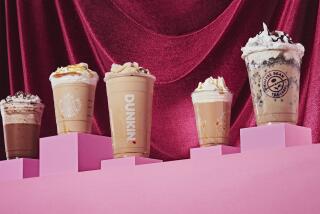A hidden jolt of calories
To the unsuspecting person looking for a refreshing treat, a 16-ounce frozen coffee confection or frothy coffee drink can sure beat run-of-the-mill java.
But although that unadorned cup of coffee has no calories before the addition of milk, cream or sugar, the same canât be said of its fancier cousins. Hot and cold lattes, espressos, mochas, cappuccinos and spiced teas known as chais can pack a hefty caloric punch. They may also supply a hefty chunk of the dayâs fat, carbohydrates and sugar.
And yet somehow, coffee tends to fall under the radar. âPeople have some idea that coffee is this calorie-less beverage and that youâre just adding âa little somethingâ to it,â said Lola OâRourke, a registered dietitian in Seattle, where Starbucks pioneered the modern coffeehouse. âIn the days when people drank coffee black, or with a little milk, cream or sugar, you probably werenât adding more than 100 calories.â
Today, depending on whether that drink is 12, 16 or 24 ounces, and whether itâs whipped up with nonfat, whole or soy milk -- or even half-and-half -- a consumer may be sipping 150 to 500 calories. A spritz of whipped cream can add 130 calories.
âI think people havenât fully incorporated that into their consciousness,â OâRourke said.
Not that the nutritional information is easy to find.
Starbucks discloses nutritional facts for all its beverages on its website, www.starbucks.com. Consumers also can find the information in a book kept in every Starbucks store.
On a recent hot morning in Beverly Hills, a visiting Katie Clarke, 26, of Boston, said she and her co-workers regularly go for Starbucks runs. Her regular order used to be a Frappuccino, a blended coffee-milk drink that can be flavored with mocha syrup, chocolate syrup, caramel, chocolate chips or toffee, until she checked the Starbucks nutritional info. A mocha Frappuccino has 290 calories, 4 grams of fat and 58 grams of carbohydrates (48 from sugar).
Now, she said, âI just try to be a little bit more aware.â Sheâs changed her regular drink to a mocha latte with nonfat milk.
Workers at Peetâs Coffee & Tea, a specialty coffee retailer founded in Berkeley, will read consumers the calorie and fat content for coffee and tea drinks. But that leaves todayâs carb-conscious dieters without carb and sugar specifics readily obtainable for packaged and many prepared foods. Peetâs espresso-based drinks are made with whole milk, and its Caffe Freddo ice blended drinks are made with 2% milk, unless patrons request otherwise, a spokeswoman said.
Step into a Coffee Bean & Tea Leaf store and youâre at a loss to know whatâs in the drink your barista is preparing. The L.A.-based chain doesnât publish its nutritional information, although it plans to make it available on its website.
However, the Coffee Bean can prepare its signature Ice Blended drinks (a mixture of ice, nonfat milk, coffee extract and proprietary flavored powders) with powders containing no added sugar (think Nutra Sweet), or no added sugar or added fat. That can halve calories, fat and carbs, the company says.
In response to a request for the unpublished nutritional breakdowns, the company provided them for lattes, iced lattes and Vanilla Ice Blended drinks, which ranged from 74 to 359 calories for 16-ounce servings without whipped cream.
The National Coffee Assn. in 1999 found that 29 million Americans drank gourmet coffee beverages daily, often for the caffeine boost.
âCaffeine is the reason I order it,â says Stephanie Pottruck of West Hollywood, of the latte or Ice Blended she gets a couple of times a week at Coffee Bean & Tea Leaf. The 26-year-old producer became a fan of Ice Blended drinks after college when she discovered the fat-free, no-sugar-added versions. âIt was exciting to me ... the idea of a milkshake that wasnât that fattening.â
Still, the growing appeal, especially among teens and college students, of gourmet coffee drinks made with sugar, sugar syrups and hydrogenated fats concerns nutritionists focused on the obesity epidemic. For example, a 24-ounce Java Chip Frappuccino from Starbucks, with chocolate chips, whipped cream and chocolate syrup, packs 650 calories, 25 grams of fat, 17 grams of saturated fat and 99 grams of carbs. Federal recommendations for a 2,000-calorie diet are to keep fat under 65 grams, saturated fat under 20 grams, carbs under 300.
Reporting in the April issue of the Journal of the American Dietetic Assn., researchers from Simmons College in Boston found that undergraduate and graduate students who drank gourmet coffee concoctions consumed an extra 200 calories and 32 grams of sugar a day.
The calorie-dense liquids arenât as satisfying as food and âdonât stop you from eating that amount of calories in something else,â OâRourke warned.
*
(BEGIN TEXT OF INFOBOX)
How the drinks stack up
Sources: Coffee Bean & Tea Leaf, Peetâs Coffee & Tea, Starbucks. Los Angeles Times
A comparison of 16-ounce servings of popular iced gourmet coffee drinks.
Iced latte (whole milk)
*--* Calories Fat* Carbs* Protein* Starbucks Iced Caffe Latte Espresso 160 8 13 8 Peetâs 150 8 n/a n/a Coffee Bean 123 7 11 7
*--*
Iced latte (nonfat milk)
*--* Calories Fat* Carbs* Protein* Starbucks Iced Caffe Latte Espresso 100 0 14 9 Peetâs 90 0 n/a n/a Coffee Bean 74 0 11 7
*--*
Blended coffee drink
*--* Calories Fat* Carbs* Protein* Starbucks Frappuccino Coffee 260 3.5 52 5 Java Chip 370 9 69 7 Peetâs Caffe Freddo Nonfat milk 215 Less than 2 n/a n/a 2% milk 235 4 n/a n/a Coffee Bean Vanilla Ice Regular powder 352 10 54 13 No sugar added, fat-free 142 2 26 12 powder
*--*
Whipped cream adds 130-140 calories, 12-13 grams of fat, 4 grams of carbs.
*Fat, carb and protein measurements expressed in grams
More to Read
Eat your way across L.A.
Get our weekly Tasting Notes newsletter for reviews, news and more.
You may occasionally receive promotional content from the Los Angeles Times.









